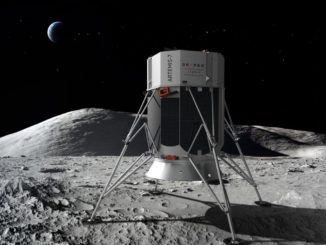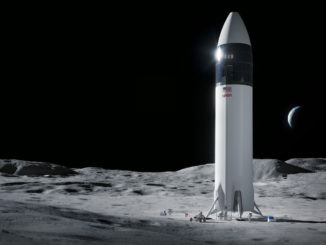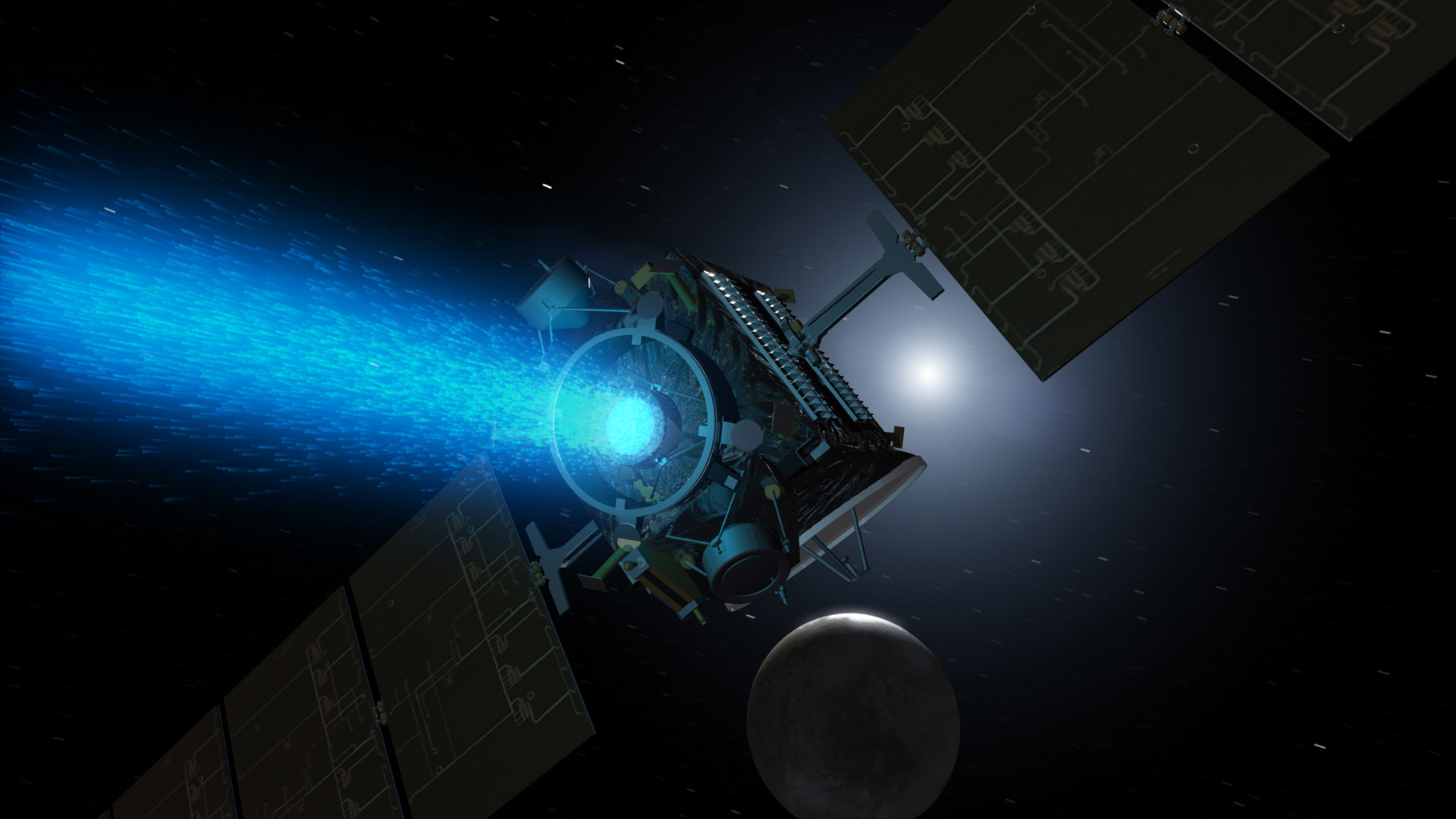
NASA’s Dawn spacecraft ran out of fuel Wednesday and stopped transmitting to Earth, ending an 11-year mission that explored the two largest objects in the asteroid belt and set several records in the annals of space history.
Dawn failed to contact controllers at NASA’s Jet Propulsion Laboratory in California during an overnight communications opportunity late Wednesday into early Thursday, and officials declared the mission over after evidence indicated the spacecraft ran out of hydrazine fuel.
The fuel depletion was long anticipated, and engineers expected Dawn to run out of hydrazine some time in September or October. Dawn apparently emptied its hydrazine tank some time Wednesday, rendering the spacecraft in orbit around the dwarf planet Ceres unable to keep its antenna pointed at Earth, or its solar arrays trained on the sun to generate electricity.
“Everybody rightly recognizes that it’s bittersweet, but I actually find it a lot sweeter than bitter,” said Marc Rayman, Dawn’s chief engineer at JPL, in an interview Thursday with Spaceflight Now. “This is the successful conclusion to a successful mission. To me, this is the best possible way for a mission to end because it was productive to the very end, and we squeezed as much as possible, even in principle, from the spacecraft, so I couldn’t be happier.”
Spaceflight Now members can read a transcript of our full interview with Marc Rayman. Become a member today and support our coverage.
“Today, we celebrate the end of our Dawn mission — its incredible technical achievements, the vital science it gave us, and the entire team who enabled the spacecraft to make these discoveries,” said Thomas Zurbuchen, associate administrator of NASA’s science mission directorate in Washington, in a statement Thursday. “The astounding images and data that Dawn collected from Vesta and Ceres are critical to understanding the history and evolution of our solar system.”
Launched from Cape Canaveral aboard a United Launch Alliance Delta 2 rocket on Sept. 27, 2007, the Dawn spacecraft traveled 4.3 billion miles (6.9 billion kilometers) through the inner solar system over the last 11 years, flying by Mars for a gravity assist maneuver in 2009 before reaching asteroid Vesta, the second-biggest object in the asteroid belt, in 2011.
The spacecraft was built by Northrop Grumman Innovation Systems, formerly known as Orbital ATK, and carried three instruments — a framing camera, and visible and infrared spectrometer, and a gamma ray and neutron detector — to investigate the geology, mineral make-up and water content of Vesta and Ceres.
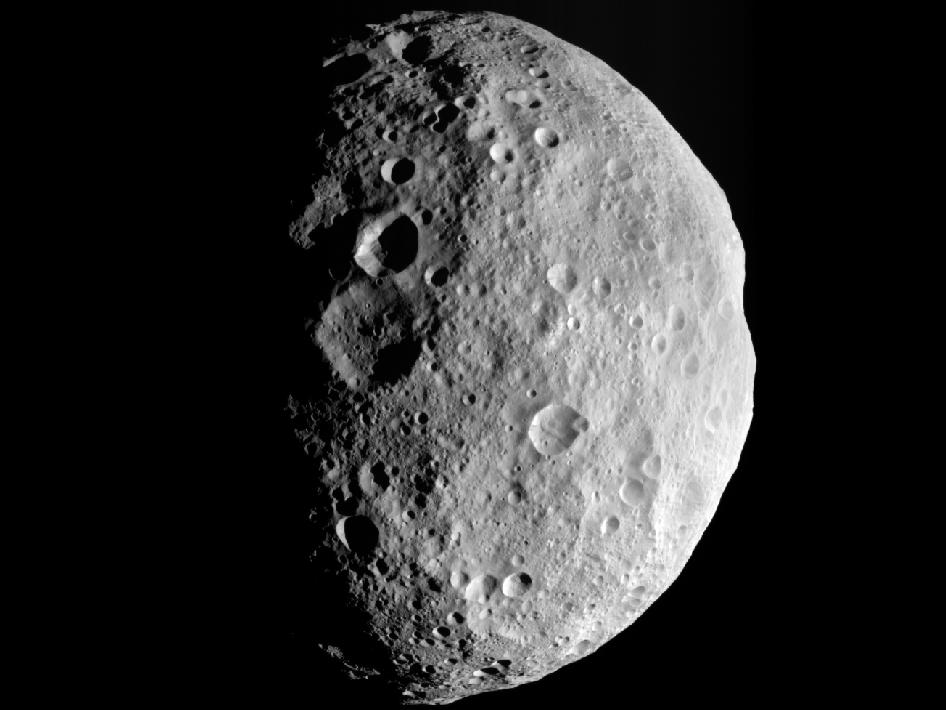
Dawn orbited Vesta more than year, using its ion engines to spiral close to the giant asteroid, then to back away and escape Vesta’s gravity field for the journey to Ceres.
Dawn’s time at Vesta yielded several big surprises, chiefly with the discovery of evidence that liquid water may have once flowed on the asteroid, Raymond said.
Scientists already have some samples from Vesta in laboratories on Earth.
Before Dawn’s mission, researchers suspected a special class of rock samples called Howardite–Eucrite–Diogenite, or HED, meteorites that fell to Earth from space were chunks knocked off Vesta by an ancient interplanetary collision.
Dawn confirmed that hypothesis, and found Vesta likely once had global tectonic activity, something scientists did not expect on such a small world. Vesta measures around 359 miles (578 kilometers) in diameter along its longest axis.
The Dawn spacecraft’s German-built camera suite found pits in the bottom of several relatively fresh craters on Vesta, suggesting volumes of gas — perhaps water vapor — were released by violent impacts with other asteroids.
Dawn’s voyage from Vesta to Ceres took nearly three years, relying on the probe’s plasma propulsion system to reshape its trajectory through the asteroid belt to intercept its next target.
The maneuvers put Dawn on course to be captured by Ceres’s gravity field in March 2015.
Before Dawn’s arrival, the best imagery of Ceres from the Hubble Space Telescope gave scientists a glimpse of the mysterious mini-planet’s appearance. Scientists knew its size and shape, and they believed Ceres might contain a sub-glacial ocean.
Ceres astonished Dawn’s team almost as soon as the spacecraft moved within visual range.
“The big surprise during the early approach phase was that there is an area of high reflectivity near Occator (Crater),” said Andreas Nathues, lead investigator for the framing camera team at the Max Planck Institute for Solar System Research in Gottingen, Germany, in a press conference last year. “It was so bright in the first images that we saturated all the chips (in the camera) because we didn’t expect such a bright feature on a dark surface.”
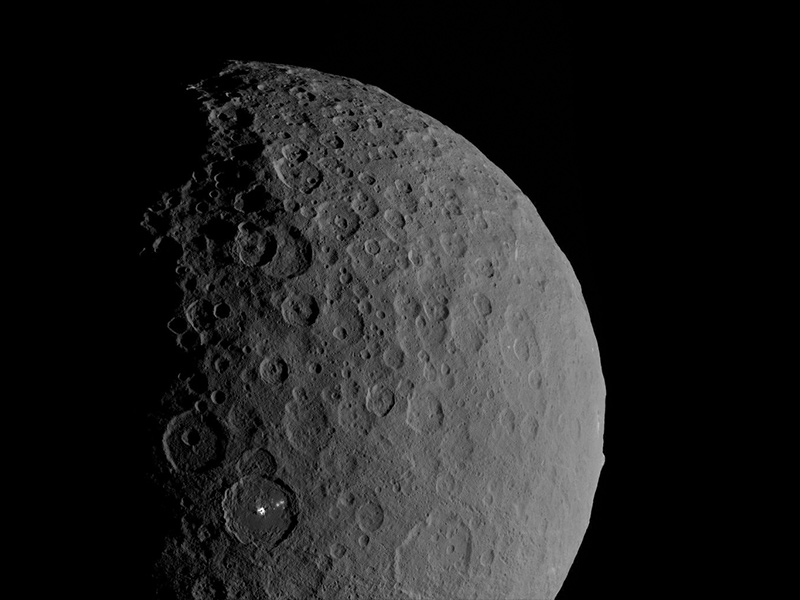
The bright spots in Occator Crater immediately triggered speculation that they might be icy patches, or perhaps an erupting volcano spewing water into space. Scientists initially favored the ice explanation, but a closer examination by Dawn’s science instruments revealed them to be deposits of sodium carbonate, a type of salt.
Scientists believe the bright salt deposits got to the surface when an ancient impactor struck Ceres, releasing melted rock and water in a complex hydrothermal or cryovolcanic system. Dawn also discovered Ahuna Mons, a three-mile-high (5-kilometer) peak that Dawn’s team believes is a dormant volcano that spewed watery material into the sky instead of rocky magma.
Dawn’s exploration of Ceres helped shape scientists’ conclusion that dwarf planets could have once harbored oceans, and contained the ingredients necessary to give rise to life.
Ceres spans around 590 miles (950 kilometers) in diameter, about one-thirteenth the size of Earth. It’s bigger than Saturn’s moon Enceladus, which hides a global ocean under its icy shell warmed by the constant tug of Saturn’s gravity on the moon’s interior, a phenomenon known as tidal heating.
“There is an affinity between some of the icy moons and Ceres, and certainly they do bear resemblances,” said Carol Raymond, Dawn’s principal investigator at JPL, in an interview with Spaceflight Now last year. “But since Ceres now lives in such a warm environment relative to those objects, it looks very different. Its ocean froze out. It doesn’t have any tidal heat. So it’s ocean is frozen, and its surface is baking relative to the icy moons. The way it formed, what it formed of, appears to be similar, but the evolutionary paths are quite different.”
Dawn’s prime mission ended in 2016, and NASA approved an extension to continue the probe’s exploration of Ceres, the biggest world between the orbits of Mars and Jupiter. Senior agency officials did not approve a proposal to fire Dawn’s trusty ion engines and escape Ceres to head for a flyby of an asteroid, concluding there was more science to be gained at Ceres than at another target.
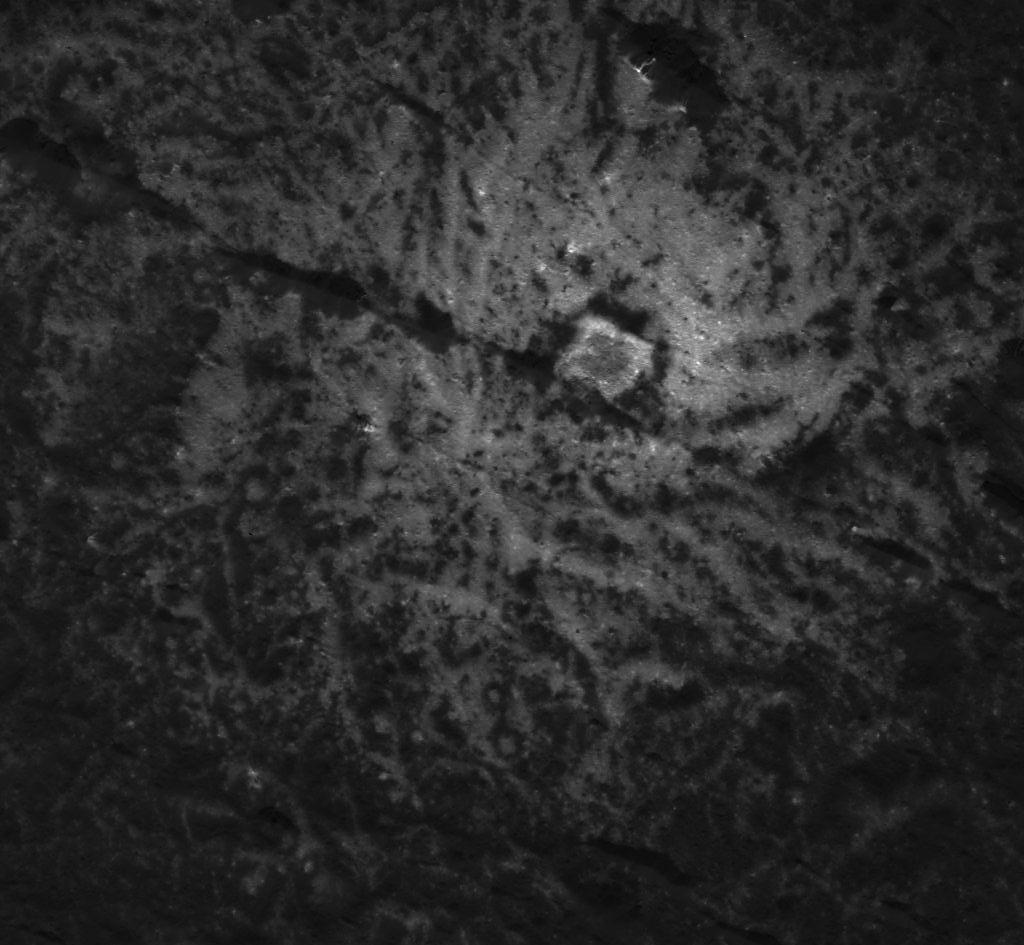
Dawn almost never made it to the launch pad.
Cost overruns and difficulties with Dawn’s electric propulsion system prompted NASA to cancel the mission in March 2006. The space agency reinstated the mission less than a month later after an appeal from managers at JPL.
“There were a couple of dramatic points,” Raymond said last year. “The first was right before launch when we learned that we were launching with defective reaction wheels, and there was nothing we could do about it. We went into a mode where we were trying to preserve wheel lifetime.”
Three of the spacecraft’s four reaction wheels failed during the mission, forcing engineers to devise a new way to control the probe’s pointing with a combination of momentum wheels and hydrazine-fueled thrusters. The spinning gyro-like wheels are designed to change their spin rate to pivot the spacecraft.
With the failure of a third reaction wheel last year, Dawn started consuming more hydrazine fuel for pointing control. The probe launched with around 100 pounds (45 kilograms) of hydrazine to feed its thrusters.
Dawn’s enduring legacy
Rayman said Dawn’s mission of exploration will leave an enduring scientific and engineering legacy.
“In science, it’s the unveiling of two of the last uncharted worlds in the inner solar system,” Rayman said. “Vesta and Ceres are the two largest bodies between Mars and Jupiter, and prior to the Dawn mission, Ceres was the largest object between the sun and Pluto that a spacecraft had not yet visited.
“The main asteroid belt has truly millions of objects in it, and yet 45 percent of that total mass is contained in Vesta and Ceres, which Dawn singlehandedly explored,” Rayman said. “I think that’s pretty impressive, and it showed us that Vesta is not just an asteroid like the others. A lot of people call it a big rock or something like that. Geologically, it’s more closely related to the terrestrial planets, one of which right underneath our feet. It’s got a dense iron-nickel core surrounded by a mantle, surrounded by a crust, and it’s more akin to the terrestrial planets than it is to the rocks we think of as asteroids.”
Dawn carried three ion engines to push the spacecraft around the solar system, setting a record for the longest run time on a plasma propulsion system in space.
Using a combination of xenon fuel and electrical power to generate low levels of thrust, ion engines are not as powerful as conventional thrusters, but they produce more of an impulse over time, providing a leap in fuel efficiency for space missions.
Dawn’s ion propulsion system took four days to accelerate the spacecraft by 60 mph (96 kilometers per hour), but the probe thrust with its ion engines for 5.9 years of cumulative operation, changing the craft’s velocity by 25,700 mph (41,400 kilometers) over the course of its mission.
That capability enabled Dawn to become the first spacecraft to orbit two solar system destinations outside of the Earth and the moon.
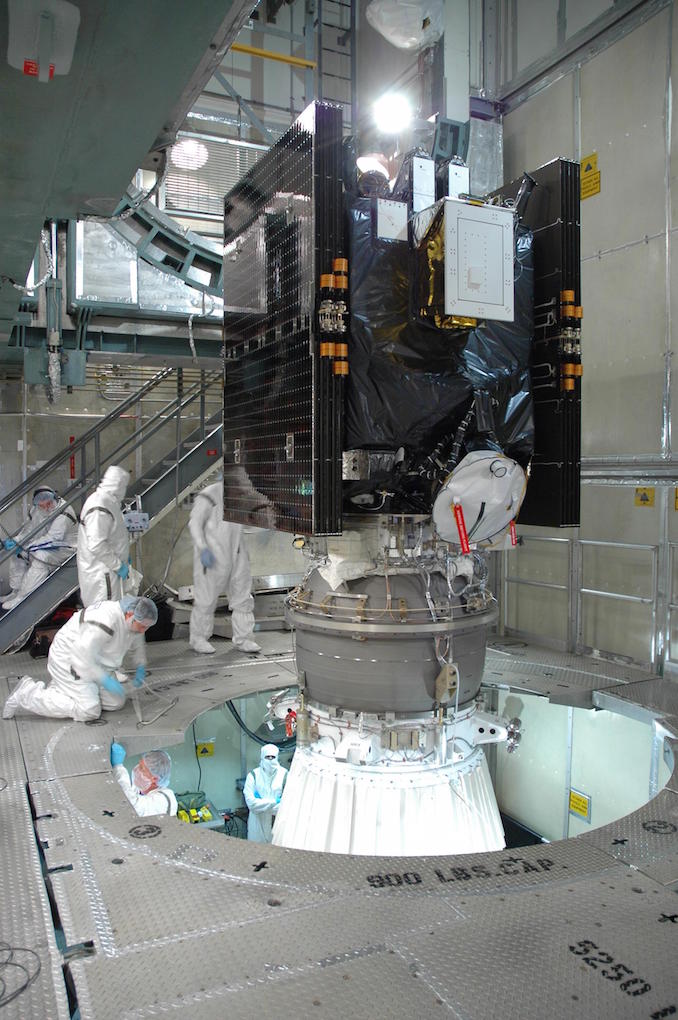
“To me, Dawn was the first interplanetary spaceship,” Rayman said. “The capability to travel to a distant alien world, go into orbit around it, and then maneuver extensively in orbit, then break out of orbit, travel through the solar system — it was two-and-a-half years and 900 million miles to get from Vesta to Ceres — go into orbit aound another alien world and explore it, I think that is really extraordinary. Indeed, it is truly unique in the more than 61 years of space exploration, and I think this bodes well for our species as we continue to reach out into the cosmos.”
“In many ways, Dawn’s legacy is just beginning,” Raymond said Thursday in a statement. “Dawn’s data sets will be deeply mined by scientists working on how planets grow and differentiate, and when and where life could have formed in our solar system. Ceres and Vesta are important to the study of distant planetary systems, too, as they provide a glimpse of the conditions that may exist around young stars.”
Rayman said Dawn’s ground team first noticed signs Wednesday that the spacecraft, located more than 300 million miles from Earth, could be out of fuel. NASA’s Deep Space Network, which comprises antennas in California, Spain and Australia, was tracking Dawn’s radio signal to measure its Doppler shift, collecting data for scientists to precisely map Ceres’s gravity field, information that could help determine variations in the dwarf planet’s internal structure.
“We actually lost the signal late in the track, so we continued to look during that track and didn’t see it, but that was not enough to to make a definitive determination that the mission was over,” Rayman said.
Dawn was not transmitting any telemetry during the Doppler track — just a blank radio signal — so controllers could not be sure of the spacecraft’s status. They waited for another communications pass late Wednesday, when engineers heard only silence.
“We didn’t see the spacecraft at all,” Rayman said. “To me, that was enough to confirm that the mission has ended because we had known for so long that we were on the verge of running out of hydrazine.”
Without hydrazine to fuel its control jets, Dawn was unable to correct its orientation, which requires regular maintenance to counteract natural forces tugging at the spacecraft, such as Ceres’s gravity and solar pressure.
Engineers expected these forces to gradually pull Dawn’s solar arrays, which span 65 feet (20 meters) tip-to-top, off their lock on the sun, leaving the spacecraft unable to recharge its batteries. Under such circumstances, on-board software was programmed to automatically switch off Dawn’s radio transmitter to conserve power until the batteries could be charged again.
“It’s smart enough to turn that radio off, save power, save battery, until it has its solar arrays on the sun, but it will never achieve that condition, so it turned the radio off, and it will not turn it back on,” Rayman said.
Dawn is the second mission NASA has declared complete this week.
NASA announced Wednesday that the Kepler space telescope has run out of fuel, ending its search for planets around other stars. Engineers plan to uplink the final commands to switch off Kepler’s radio as soon as next week.
NASA selected the Dawn and Kepler missions on Dec. 21, 2001, after a competition among other mission proposals to win federal funding under the space agency’s Discovery program, a series of relatively low-cost, science-focused robotic space missions.
Kepler launched in March 2009, and also suffered reaction wheel trouble during its mission.
“They were selected the same day,” Rayman said. “Of course, they launched far apart. Kepler launched in 2009, and Dawn launched in 2007. So the same start and the same ending, but very different lives in between, but it is an interesting coincidence.”
Dawn will remain in its current orbit around Ceres for the foreseeable future. The spacecraft maneuvered into an egg-shaped orbit earlier this year that takes Dawn around Ceres once every 27 hours, passing as close as 22 miles (35 kilometers) above its surface on each orbit, closer to Ceres than Dawn ever flew before.
“We have a planetary protection requirement that Dawn not contact Ceres for at least 20 years,” Rayman said. “The reason for that is because Ceres has a substantial amount of water. Most of it’s frozen, but some of it could still be liquid. It has organic materials that Dawn has detected. It has a rich inventory of other chemicals as well … So it has many of the ingredients that are important, or that are interesting, for the study of the chemistry that leads to the development of life.”
NASA does not want to contaminate Ceres with debris from Dawn, ensuring that the icy world in the asteroid belt remains pristine for future missions to study.
“(Our) analysis shows quite clearly that there’s no chance of impact in 20 years, and even in 50 years, there’s less than a 1 percent chance that the spacecraft will hit the ground. So it’s going to be there in orbit for a very long time,” Rayman said.
Email the author.
Follow Stephen Clark on Twitter: @StephenClark1.

